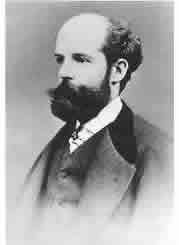Georges Leclanché (1839-1882)
 In1866, Georges Leclanche, patented a new system, which was immediately successful. In the space of two years, twenty thousand of his cells were being used in the telegraph system. Leclanche's original cell was assembled in a porous pot. The positive electrode consisted of crushed manganese dioxide with a little carbon mixed in. The negative pole was a zinc rod. The cathode was packed into the pot, and a carbon rod was inserted to act as a currency collector. The anode or zinc rod and the pot were then immersed in an ammonium chloride solution. The liquid acted as the electrolyte, readily seeping through the porous cup and making contact with the cathode material. Leclanche's "wet"cell (as it was popularly referred to) became the forerunner to the world's first widely used battery, the zinc carbon cell.
In1866, Georges Leclanche, patented a new system, which was immediately successful. In the space of two years, twenty thousand of his cells were being used in the telegraph system. Leclanche's original cell was assembled in a porous pot. The positive electrode consisted of crushed manganese dioxide with a little carbon mixed in. The negative pole was a zinc rod. The cathode was packed into the pot, and a carbon rod was inserted to act as a currency collector. The anode or zinc rod and the pot were then immersed in an ammonium chloride solution. The liquid acted as the electrolyte, readily seeping through the porous cup and making contact with the cathode material. Leclanche's "wet"cell (as it was popularly referred to) became the forerunner to the world's first widely used battery, the zinc carbon cell. The Leclanche cell was used extensively for telegraphy, signaling and electric bell work; and for most work where intermittent current is required and where it is essential that the battery should require very little attention. The cell proved very useful in the early years of the telephone, before power was centralised in the exchanges, every telephone needed to have its own source of electricity. The battery was hidden inside a wooden box, often fixed with the telephone on the wall. It proved less suitable as conversations lengthened, and for long-distance calls. In a prolonged call, the start might be fine, but the conclusion could well be inaudible, as the battery ran down. However, the Leclanche was to some extent self re-charging, thanks to the chemicals inside it reacting with the surrounding air and before too long the telephone would be ready for action again.
The Leclanche cell was used extensively for telegraphy, signaling and electric bell work; and for most work where intermittent current is required and where it is essential that the battery should require very little attention. The cell proved very useful in the early years of the telephone, before power was centralised in the exchanges, every telephone needed to have its own source of electricity. The battery was hidden inside a wooden box, often fixed with the telephone on the wall. It proved less suitable as conversations lengthened, and for long-distance calls. In a prolonged call, the start might be fine, but the conclusion could well be inaudible, as the battery ran down. However, the Leclanche was to some extent self re-charging, thanks to the chemicals inside it reacting with the surrounding air and before too long the telephone would be ready for action again.